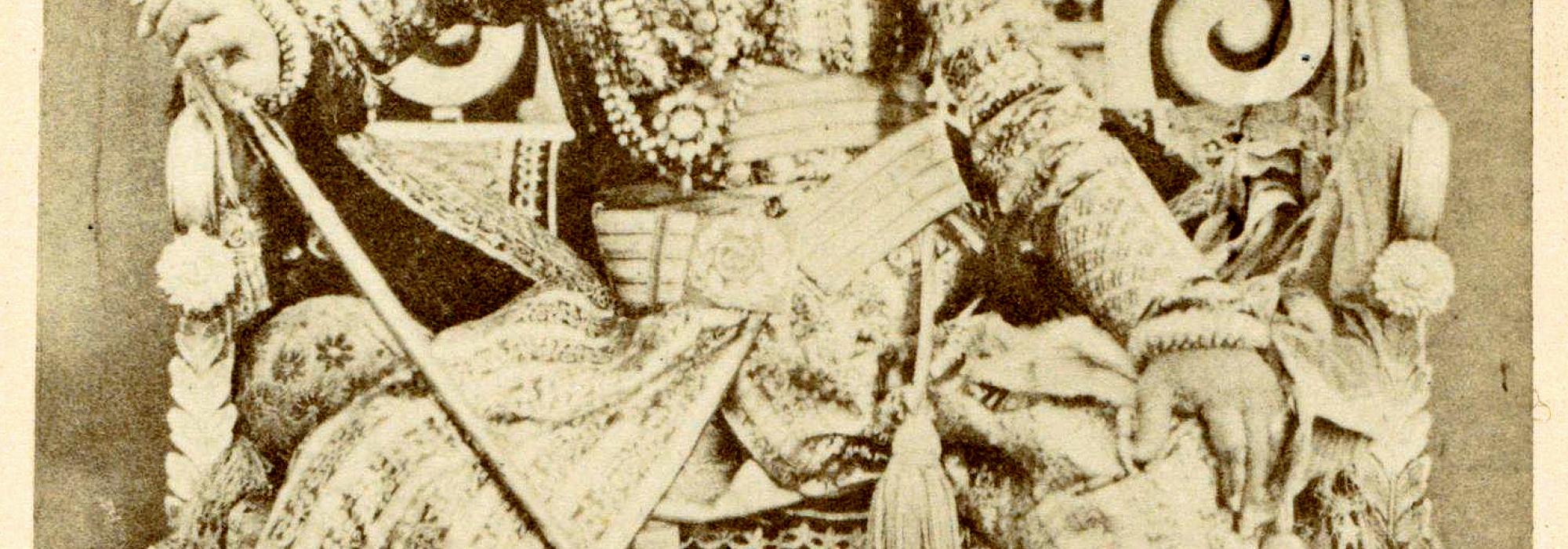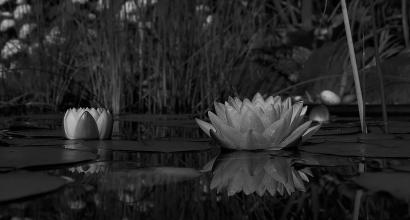Rumāle Śāmabhaṭṭa
Now, this Vēṅkaṭaśarma was not one among my ancestors. It was a person named Śāmabhaṭṭa who was my predecessor. A Vedic practitioner by birth, Śāmabhaṭṭa, chose the profession of a Shanbhogue [1]for a livelihood, which brought unto him, an official turban or a roomal, thus earning him the title of Rumāle Śāmabhaṭṭa. Now this title might've been a banter, and very much akin to the case of the esteemed, Chappalli Viśveśvara Śāstri, as mentioned by me elsewhere –
Śāstrībhāvamupākṛtya
Mestrībhāvamupāgataḥ
(Having served the Priesthood, He assumed the Masonhood)
It took generations after Śāmabhaṭṭa, for Gundappa, my great grandfather, to be born. He was the son of Venkaṭagiriyappa (or Venkaṭaramaṇayya). He must've had siblings too, for their bloodline remains intact till date.
I know not of the village where Gundappa was born, for his brothers were staying in three to four different villages, namely, Tattanahalli, Mattanahalli and Somathanahalli. Gundappa probably hailed from Somathanahalli.
Kāmākṣamma
Gundappa’s wife Kāmākṣamma belonged to Sarjapura. Her father, I presume, must've been well off, for he had gifted her two acres of land in a place called Muttānallūr, that would suffice her daily bread and butter. Adding to it, he had also gifted her a Śri Cakra with a figure of Lakṣmi on it, casted out of pure gold, and a pair of lamps, to enable her to perform the daily Gaurīpūjā. All of these were safe, at least till my childhood. The Śri Cakra measured two inches in width and three in length. The geometrical component of Śri Cakra occupied only one half of it. The other half housed the figure of Lakṣmi. Now this Śri Cakra underwent daily worship, with my mother performing the Kuṅkumārcana or the Vermillion Service to it, devotedly on the Fridays. As the Śri Cakra wore off with the passing of time, and grew unworthy of even a mere touch, it was topped up with more of fresh gold and it remained unblemished for many days after that. A Brāhmaṇa priest was appointed for its worship post my father’s demise. My mother too, was forced to remain busy in the kitchens most of the times and hence couldn’t pay much heed to the things placed for pūjā of the deities worship area and the idol seems to have disappeared somehow.
The pair of lamps were made of brass and measured around three to four feet in height. They were sturdy enough and could accomodate upto eight wicks in their oil cavities. Any auspicious event in our village, and these lamps were sure to be borrowed, to be placed before the pallet. And thus, someone who had once borrowed them “forgot” to return them.
And then it was only the land that remained. There were absolutely none to monitor the harvest that the land produced. Kāmākṣamma's third son, Śīnappa, also a brother to my grandfather, ventured out to visit the village of Sarjapura and around, twice or thrice annually, and would even resort to the collection of the lease amount of the land, if he remembered, by any chance. My father visited that region once in three to four annums, and everytime he demanded the lease amount, in reply the peasants said, “We've already paid him, sir”. It is quite doubtful that either of them were paid. After a couple of rounds in this silly game, I remember, albeit vaguely, that the two-acred land was finally sold off.
Shekdar Gundappa
Let us deep dive into the story of Gundappa. He was a resident of quite a few villages including Somathanahalli - all those villages were a part of the Devanahalli Taluk. Though I'm unaware of his educational feats, the stories about him reveal that his working skills fared better than his scholastic excellence. He must have been an employee of meagre jobs, serving a certain Taluk office, during his initial days. It was only during the earlier days of the British Commissioner times, he could secure a sound job.
So, Tipu Sultan, the Nawab of Mysore, died in the year 1799, did he not? The young Krishnaraja Wadiyar, the Third of his name, ascended the throne and ruled till 1831 thereafter. It was the rule of the British Commission that followed him, supposedly that of Sir Mark Cubbon’s. It was around then that Gundappa was posted the Shekdar of Mulabagal. I probable this incident to date back to two decades over a century from now, sometime during the 1860s.
The Military March
The British, back then, were watchful for obvious reasons. This land was alien to them. They feared their rivals, the Marathas and the Nizams and their plots. They feared an outbreak of a revolt by the masses. And thus, they were very keen on the safeguarding peace within the country. The Military March supported this idea of theirs with a form. The British cantonment was in Bangalore then. The British army battalion in Bangalore marched towards Madras, once in a month, with another battalion from Madras marching into the Bangalore cantonment. The battalions had to march all their way to the destination. The frequent marches of the battalions instilled a sense of fear among the masses, regarding the power and the pride that the British wielded. The exercise would discipline the soldiers while helping them to break their blues. And therefore, the marching battalions were provided with accomodations at the two to three halts en route. Mulabagal was one such halt. It lies at the exact 60th mile from Bangalore. For two or three days, a battalion halted here, before marching further.
The military diet demanded paramount importance during the halt of the battalion. The men, known as Kalāsis, would at first arrive to lay out the tents and the battalion along with its officers would then walk in. The military camp would be set up in a field, two miles to the east of Mulabagal. The Commissariat was responsible for the supply of food and drinks to the battalion and therefore, Shekdar Gundappa had to shoulder this responsibility. This required him to assign contracts to various contract holders, to ensure a smooth and a regular supply of food items, including chicken, mutton, milk, curds, semolina, rice and sugar. The yesteryear fables about him reveal his adroitness in handling such massive responsibilities.
The Dietary Arrangements
An elderly person, Kogileri Śīnappa, who was a contemporary of Shekdar Gundappa, has narrated to me the incidents related to him. The house in which he lived was situated onto the same side of the lane as ours. Śīnappa was a Shanbhogue himself, and a proud holder of land. Śīnappa was of an immensely affectionate character. With me seated beside him, he often narrated the merits of my great grandfather to me.
Gundappa's appearance was modest and neither among low or towering. He was a little stocky, however, and oily red in complexion. The intimidating look on his face would daunt the folk a little. Ever brimming with gusto, a smile would seldom adorn his face. But this would mostly show up during the enforcement of the order. He seemed judicious and caring, otherwise.
The Routine
Gundappa, every morning, bathed in a quadrilateral stepped-tank, known as Doḍḍakunṭe, situated at the heart of the village, perform his daily rituals such as the Āhnika[2], and cover his forehead with Vibhūti[3]. He would then dress up in a kurta, with a sash around his neck and set out to the market. Near the market square, he would call out the names of the traders, in colloquial Telugu –
Gundappa: సంజీవా...! (Hey, Sanjeeva...!)
(This referred to Namburi Sanjeeva Setty)
Sanjeeva Setty: స్వామి ? (Yes sir ?)
Gundappa: నయ్యుందేమిరా ? (Do you have you ghee?)
Sanjeeva Setty: ఉంది స్వామి ! (Indeed sir !)
Gundappa: తిస్కొని రా !...ఎన్నాళ్ళదో...కంపు పట్టి పయ్యిండేది (Fetch it here...Must be stinking out of staleness by now...To hell with your sense of smell!)
Sanjeeva Setty: లేదండి కొత్తది! (Not at all sir, it's fresh!)
(And he would bring a pot full of it)
Gundappa: బెల్లం ముద్ద ఎక్కడ ? (Where's the nugget of jaggery ?)
A fresh nugget of jaggery would be placed before him. The region had no jaggery moulds then, plus there were no mills of iron, but wood, to press the sugarcane. Thus, the quality of the produced jaggery would be fine enough. Sans grime, the jaggery barely turned sour, and remained a treat to the taste buds. Sanjeeva Setty would offer him such a nugget of jaggery. Gundappa would then bring down a hard blow on the nugget with his fist, leaving the nugget in four to five chunks. A chunk, he would pick with two of his fingers, dunk it in the pot of ghee and lower it into his mouth. The taste of it, if pleasing enough, determined a contract to the trader.
And another shop he would walk into.
Gundappa: వొరేయ్ రంగడు! రవ ఉందేమిరా? (Hey Ranga! Have you semolina ?)
Rangayya Setty: ఉంది స్వామి (Indeed sir)
Gundappa: తే చూతాము! (Let us see, fetch it here)
The same would appear before him in a pan, about half a seir (466 grams) of it. He would examine a handful of it and then demand –
Gundappa: నయ్యుందో ? (Have you ghee ?)
A pot of ghee would be placed before him by Rangayya Setty.
Gundappa would then dig his hand into the pot, and taking a palmful of dripping ghee from it, he would mix it well with the semolina, and rolling out balls of it, he gulped them.
Astounded by the incident, when I questioned Śīnappa, if such a thing as gulping down raw semolina was even possible, he replied, “Why would I even lie? What a man your great grandfather was, indeed! Akin to Bhimasena's, his tummy could assimilate anything and everything”.
Gundappa would then walk down to the market square. The livestock breeders from the villages nearby sold their produce of curds and ghee there. A pot of curd, Gundappa would lift and chug it down to his heart's fill. If he found it to be gratifying enough, that guranteed the seller, a sale of fifty pots of curd.
To be continued...
This is the second part of a three-part English translation of the first essay in D V Gundappa’s magnum-opus Jnapakachitrashaale (Volume 8) – Sankeerna-Samputa. Edited by Arjun Bharadwaj.
Footnotes
[1] The accountant of a village, or a cluster of villages
[2] Daily rituals











































